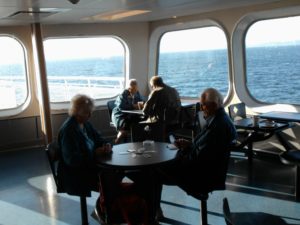
All of us are pilgrims on the earth. I’ve even heard it said that the earth itself is a pilgrim in the heavens.–Maxim Gorky (1903)
On the ferry from Nanaimo to Vancouver today. A beautiful, warm, sunny day; the channel islands, lighthouses, and boats coming into view and silently slipping past; my companions the sound of the ferry cutting through the water and the rumble of the engines. Have you ever noticed the emotions on leaving a place familiar and arriving somewhere new or half-remembered? There is something important about the pauses between places, for they teach us to connect to an intrinsic order within life’s transitions.
Departures and arrivals are part of our human ancestry; breaking camp to follow seasons and food. Leaving and arriving are fundamentally connected to the rhythms of life—relationship beginnings and endings, rites of passage, birth and death, even day and night. Within a transition, there are distinct times when you are between places. What to do in these in-between places? Numbing is easy, especially with electronics. Kosho Uchiyama called such things “distractions from real life”; when we use what he calls “toys” as a way of not being present, we lose out on the richness that is the world and our lives become the poorer. The world too, neglected, becomes the wasteland of our eco fears. The richness on a voyage is present in connecting to an intrinsic order which guides us through change. To connect to this rhythm, you must accept the pain—allow yourself to feel the sadness of leaving somewhere known and the anticipation at arrival, or whatever emotions are brought up for you. As the beat of a ship’s great engine resonates our own heartbeat, emotional processing connects us to the rhythm of change, helping us move from one place to another.
On journeys, do people stare out the window anymore, in reverie with their own thoughts, happy or sad, their inner rhythms of coming and going? Being lost in thought, mental meditation, writing, and walking are ways to deepen into transition. Walking attunes you to your body’s rhythms, its ability to express and work through feelings physically. Connecting helps you access a wisdom greater than that of the individual “I” and it is amazing the wisdom for transition we possesses if we are still and not distracted. This is probably why so much great literature has been written on journeys, and on ships.
Some transitions in life are happier than others—the birth of a baby, buying your first house, a wedding. Others—the death of someone close, illness, divorce, the ending of a close relationship, financial loss—are not so joyous. Sometimes, it is all we can do is hold on, trusting that life will carry us through. As on a ship in rough waters, we ride the high emotional waves which feel so intense at their peak (yet do not last forever). Jerome K. Jerome expresses this so well:
Sometimes, our pain is very deep and real, and we stand before her [the earth] very silent, because there is no language for our pain, only a moan. Night’s heart is full of pity for us: she cannot ease our aching; she takes our hand in hers, and the little world grows very small and very far away beneath us, and, borne on her dark wings, we pass for a moment into a mightier Presence than her own, and in the wondrous light of that great Presence, all human life lies like a book before us, and we know that Pain and Sorrow are but angels of God. (Three Men in a Boat (To say Nothing of the Dog!), p. 86)
In my counselling practice, I work with clients undergoing difficult life transitions—death or divorce, loss of a job, an empty house. One of the first things I help clients do is normalize difficult feelings; there is no tippy-toeing around a tough life change. Half the battle is the ego’s belief that one shouldn’t be so upset, and it is this very belief that keeps you from connecting to the rhythm within transition. In the middle phase of therapy, I help clients with the emotional processing that attunes us to the rhythms of life change. Finding tools that work is an essential part of this process, for one shoe does not fit all. The third phase is putting it together, moving into a new phase of life, which can feel different, uncomfortable, or even unwanted at first. Eventually, you can work through life changes and find meaning, peace, and calm. By engaging with your emotions, by fully feeling the movement from port to port, you will be much more present when you arrive.
Big ships have rhythms of their own. A ship seems to know on the sea it is between places. After leaving port it adjusts; panels creak and move, metal stretches, and the boat moves with the water; it’s engines humming, connected to the sea’s greater rhythms. The feel of the wind, the rumble of the engines–many sensory riches are close by. I can close my eyes and feel the movement from here to there… And it helps not having internet or phone access on the ferry.
Greetings to you on your journeys.
